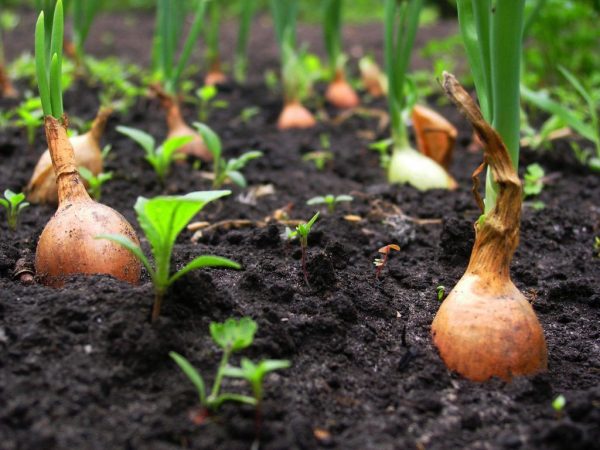When to remove onion sets from the garden
Growing onions in your area is quite simple. Depending on the weather and the variety, you need to know when to harvest the onion sets. There is no universal period for collecting plantings. There are many factors to be guided by. When to remove onion sets from the garden, you can find out if you make simple calculations for which you need to know the planting time and the ripening time of the vegetable.

When to remove onion sets from the garden
On average, harvesting of all onion sets begins approximately 70 days after planting. In the Urals, Siberia or central Russia, you can harvest a vegetable at different times, since the climate in these zones may differ. If the summer season was warm and not rainy, then onions are harvested earlier than expected. You can focus on the beginning of the first cool nights at the end of the summer period.
Signs of ripe onions
- The feather begins to turn slightly yellow and dry.
- The plant is lowered to the ground.
- The neck of the onion becomes thinner.
Preparing onions for harvesting
When the harvest time for the sevka is determined, you need to prepare the planting for assembly. Before harvesting onions, you need to stop watering the beds. Collect sevok only on dry soil. It is important to timing correctly so that harvesting occurs on sunny and dry days. If the weather is rainy, then harvesting the plantings should be postponed. In damp weather, the bulb may start to rot and will not last long. Onions that have not lodged in the beds must be placed on dry ground on their own. Sevok should be removed correctly, for this it is better to dig it out.
The assembly process must be carried out slowly and very carefully.
Each onion must be dug out one at a time along with the leaves. The soil should not be shaken off the bulb, but gently wiped off. This measure protects the planting from damage and helps to extend the shelf life. After the entire set is collected, it should be laid out on top of the soil for a while, so that it matures and dries.
If the plans are to lay out the onions in the morning when dew is gathering, then the bulbs must first be covered with foil. If the weather is cloudy and sunny days are not expected, then after harvesting it is not worth laying out the seedlings on the garden bed, it is best to remove it under a canopy in the open air and dry it in this position. You can see how to properly lay out the sevok in the garden in a photo or video.
Collection of onion sets
You can harvest vegetables when sunny weather ends, and harvest should be done on an extreme sunny day. On average, in the central territory of Russia, the collection of plantings falls on the period from August to September. Gardeners should be guided by this time. Before your estimated picking time, you need to check the weather report and select a few days to pick vegetables. Also, the gardener can take into account the signs of the lunar calendar, when there are special days for planting and harvesting.
If you grow, collect and store onions incorrectly, gardeners who grow vegetables for sale may not make a profit: if you collect and store the set incorrectly, then such an onion will not cost anything on the market, so it is important to take the harvest responsibly and correctly calculate the day. When planting onions, remember and save its name, ripening period and possible features.
Proper storage of onions
It is very important to store the bulb properly after harvest. Storage is best done in a warm and dry place. In a private home, you can store vegetables in the basement or storage. In a city apartment, it is best to store it on an insulated balcony or in a pantry. Storing vegetables is permissible in special containers that allow air to pass through. It is best to store the bulbs in boxes or nets that do not damp or dry out the vegetables. Before putting the onion for storage, it is necessary to clean it from dirt, if there are rotten places, they should be removed.
Before packing for storage, the crop must be dried in the open air for several days. If a bulb does not dry out, pathogenic bacteria and fungal infection can form on it during storage. To prevent this from happening, you need to properly prepare the bulbs for long-term storage and observe the temperature regime in the room. It is required to ensure that the basement or storage room is no more than 17-25 ° C. Onions that can only be eaten can be stored at a temperature of 1-3 ° C. The air humidity should not be higher than 70-90%, otherwise the bulbs will begin to sprout, and such a vegetable is no longer suitable for consumption.


